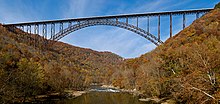New River Gorge Bridge
| New River Gorge Bridge | |
|---|---|
 |
|
| Coordinates | 38°4.1′N 81°5.0′W / 38.0683°N 81.0833°WCoordinates: 38°4.1′N 81°5.0′W / 38.0683°N 81.0833°W |
| Carries |
|
| Crosses |
New River, |
| Locale | Fayette County, West Virginia, U.S. |
| Maintained by | West Virginia Division of Highways |
| Characteristics | |
| Design | Arch |
| Total length | 3,030 ft (924 m) |
| Width | 69.3 ft (21.1 m), 4 lanes with center divider |
| Height | 876 ft (267 m) |
| Longest span | 1,700 ft (518.2 m) |
| Clearance above | Deck arch, unlimited clearance |
| History | |
| Opened | October 22, 1977 |
| Statistics | |
| Daily traffic | 16,200 vehicles/day |
|
New River Gorge Bridge
|
|
| NRHP Reference # | 13000603 |
| Added to NRHP | August 14, 2013 |
The New River Gorge Bridge is a steel arch bridge 3,030 feet (924 m) long over the New River Gorge near Fayetteville, West Virginia, in the Appalachian Mountains of the eastern United States. With an arch 1,700 feet (518 m) long, the New River Gorge Bridge was for many years the world's longest single-span arch bridge; it is now the third longest. Part of U.S. Route 19, its construction marked the completion of Corridor L of the Appalachian Development Highway System. The bridge is crossed by an average of 16,200 motor vehicles per day.
The roadway of the New River Gorge Bridge is 876 feet (267 m) above the New River. The New River Gorge Bridge is one of the highest vehicular bridges in the world, and is currently the third highest in the United States. In 2005, the structure gained nationwide attention when the US Mint issued the West Virginia state quarter with the bridge depicted on one side. In 2013, the bridge was listed on the National Register of Historic Places.
Construction began on the bridge in June 1974, and completed on October 22, 1977. It was designed by the Michael Baker Company, under the direction of Chief Engineer Clarence V. Knudsen, and executed by U.S. Steel's American Bridge Division. Final cost of construction was $37 million (approximately $4 million over bid). It is made from COR-TEN steel. The use of COR-TEN in construction presented several challenges; notable among them was ensuring that the weld-points weathered at the same rate as the rest of the steel.
...
Wikipedia

